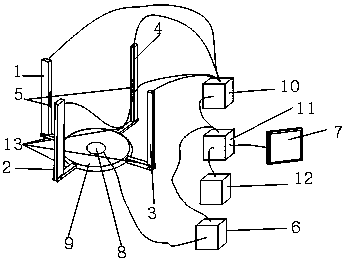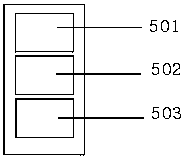Device for acquiring three-dimensional data of human body by adopting backside illuminated CMOS sensor.
A CMOS sensor, back-illuminated technology, applied in the field of three-dimensional measurement, can solve the problem that the actual size and model of the occluded parts of the human body clothing cannot be confirmed
- Summary
- Abstract
- Description
- Claims
- Application Information
AI Technical Summary
Problems solved by technology
Method used
Image
Examples
Embodiment Construction
[0039] Start the scanning device, and when the human body under test walks into the center of the test platform (8 in the figure), the depth cameras on the 4 brackets will collect images and depth information in 4 directions, and adjust the depth camera according to the ambient light. To fill in light, turn on the LEDs (502 in the figure) to fill in the light, and the data in 4 directions are generated on the data acquisition main board (10 in the figure) and then transmitted to the modeling host (11 in the figure) through the network. The modeling process Through the touch screen to interact with the user (7 in the figure), the modeling status is displayed synchronously. After collecting data from each part multiple times, the actual parameters after measurement are removed by symmetrical contrast and fuzzy modeling methods based on big data and pre-set parameters. After the thickness and clothing folds are modeled, during the acquisition process, the non-fitting part of the h...
PUM
 Login to View More
Login to View More Abstract
Description
Claims
Application Information
 Login to View More
Login to View More - R&D
- Intellectual Property
- Life Sciences
- Materials
- Tech Scout
- Unparalleled Data Quality
- Higher Quality Content
- 60% Fewer Hallucinations
Browse by: Latest US Patents, China's latest patents, Technical Efficacy Thesaurus, Application Domain, Technology Topic, Popular Technical Reports.
© 2025 PatSnap. All rights reserved.Legal|Privacy policy|Modern Slavery Act Transparency Statement|Sitemap|About US| Contact US: help@patsnap.com



